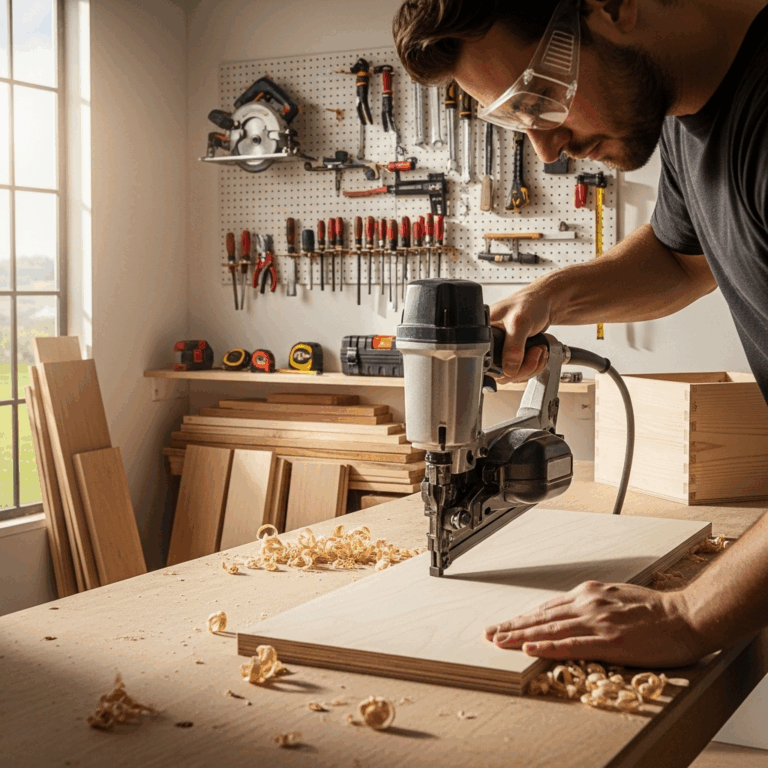Quick Summary:
To choose the right air compressor for multiple nail guns, focus on SCFM (Standard Cubic Feet per Minute) and PSI (Pounds per Square Inch) ratings. Match these to the combined demand of your nail guns, adding a buffer for simultaneous use and job duration. A higher tank size offers more reserve air, ideal for continuous operation.
Hey there, fellow DIYers and woodworkers! Jack Shaffer here from Nailerguy. Ever found yourself wrestling with a nail gun that just won’t get the job done because it’s not getting enough air? It’s a frustrating problem, especially when you’re trying to tackle bigger projects that require more than one nailer, or even just switching between different types of nail guns on the fly. You’ve got your framing nailer ready for those structural pieces, your finish nailer for trim, and maybe even a brad nailer for delicate work. But if your air compressor can’t keep up, your project hits a wall. Don’t sweat it! I’m here to break down exactly what you need to know to pick the perfect air compressor that can power all your nail guns, no matter how demanding your projects get. We’ll walk through it step-by-step, making sure you get the right power and the right features so you can nail it every time.
Table of Contents
Understanding Your Nail Guns’ Air Needs
Before we dive into compressor specs, it’s crucial to understand what your nail guns actually need to perform at their best. Think of your nail gun like a car engine and the air compressor as its fuel. If you don’t give it enough fuel, it sputters and stalls. In the world of air tools, this “fuel” is measured in two key metrics: PSI (Pounds per Square Inch) and CFM (Cubic Feet per Minute).
PSI: The Push Needed
PSI tells you how much force the air has. Most nail guns operate within a specific PSI range, typically between 70-120 PSI. Your nail gun’s manual will specify its ideal operating pressure. Too low, and your nails won’t drive fully, leading to frustrating callbacks and re-firing. Too high, and you risk damaging the workpiece or even the nail gun itself.
CFM: The Volume of Air
This is arguably the more critical spec when you’re thinking about multiple nail guns. CFM refers to the volume of air the tool uses over time. It’s often expressed as SCFM (Standard Cubic Feet per Minute), which is air volume measured at standardized temperature and pressure conditions. This standardization is important for comparing compressors accurately.
Different nail guns have different CFM requirements. For example:
- Brad Nailers & Staplers: These are low-demand tools, often using around 0.5 to 1.0 SCFM.
- Finish Nailers: They use a bit more, generally in the 1.0 to 2.0 SCFM range.
- Framing Nailers: These are the heavy hitters, requiring anywhere from 2.0 to 4.0+ SCFM, especially when firing rapidly.
- Impact Wrenches/Sanders: If you’re thinking beyond nail guns, these tools can consume significantly more air, often 5-10+ SCFM.
The key takeaway here is that while a brad nailer might be content with a small compressor, a framing nailer will demand much more. If you plan to use multiple nailers, you need to account for their combined air usage.
Calculating Your Total CFM Demand
This is where the “multiple nail guns” part of the equation really comes into play. If you’re going to be using two nailers at the same time, or if you’re switching between them frequently on a bigger job, you need a compressor that can supply the air for both. The general rule of thumb is to add up the SCFM requirements of the nail guns you anticipate using simultaneously.
Let’s say you’re working on a large project that requires both framing and sheathing. Your framing nailer needs about 2.5 SCFM at 90 PSI, and your sheathing/framing nailer needs about 3.0 SCFM at 90 PSI. If you might use them back-to-back or even at the same time (highly unlikely but good to plan for), you’d look at a compressor that can deliver:
2.5 SCFM (Framing Nailer) + 3.0 SCFM (Sheathing Nailer) = 5.5 SCFM
This 5.5 SCFM is your minimum demand. However, it’s always wise to add a buffer. Professional builders often add a 30-50% buffer to ensure the compressor isn’t constantly running at its absolute limit, which improves its lifespan and your workflow.
The Buffer Zone: Why You Need Extra
Why the buffer? Several reasons:
- Continuous Operation: Many projects require sustained nailing. A compressor that’s just barely meeting your needs will constantly be cycling on and off, interrupting your work and straining the motor.
- Tool Variation: Even within the same class of nail gun, there can be slight variations in air consumption.
- Hose Length & Diameter: Longer and narrower air hoses can reduce the available PSI and CFM at the tool.
- Future Needs: You might buy another nailer later! Having a little extra capacity keeps your compressor useful for a wider range of tasks.
So, for our example, adding a 40% buffer to 5.5 SCFM:
5.5 SCFM 1.40 = 7.7 SCFM
This means you’d be looking for a compressor that can reliably deliver at least 7.7 SCFM at the required PSI (usually 90 PSI for nail guns). Always check the manufacturer’s specifications for SCFM ratings at 90 PSI. This is the standard measurement that most tool manufacturers use.
Compressor Tank Size: More Air Reserve
Once you’ve figured out the required CFM and PSI, the next important factor is the tank size. Tank size is measured in gallons (gal) and determines how much compressed air you can store. Think of it like a water tank – the bigger the tank, the longer you can draw water before it needs to refill.
Small Tasks vs. Big Jobs
- Smaller Tanks (1-6 Gallons): These are great for intermittent tasks with low-demand tools like brad nailers or staplers. They’re portable but will need to run more frequently for tougher jobs.
- Medium Tanks (10-30 Gallons): These offer a good balance for occasional use with finish or some framing nailers. They provide a decent air reserve without being excessively heavy.
- Larger Tanks (60+ Gallons): These are ideal for workshops, extended use of multiple nail guns, or when you might need to run more demanding tools for longer periods. They offer a substantial air reserve, leading to fewer interruptions and a more consistent workflow.
For powering multiple nail guns consistently, especially framing nailers, a larger tank (30 gallons and up) is highly recommended. A larger tank allows the compressor’s motor to run less often, reducing wear and tear and providing a smoother supply of air. This means you can nail longer without the compressor cutting out or the pressure dropping.
If you’re working on a new home build, for instance, where you’ll likely be using a framing nailer for hours on end, a smaller tank will quickly become a bottleneck. You’ll be waiting for it to catch up more than you’ll be driving nails.
Compressor Types: What’s the Difference?
There are a few main types of air compressors you’ll encounter, and understanding their differences will help you choose the right one for your needs.
1. Hot Dog Compressors (Pancake/Single Tank)
These are typically small, lightweight, and very portable. They often have a single, short tank. Pancake compressors are known for their affordability and ease of transport. They’re great for homeowner tasks like inflating tires, powering a brad nailer for trim work, or simple DIY projects.
- Pros: Very portable, affordable, easy to store, good for light-duty tasks.
- Cons: Limited air reserve, lower CFM output, can be noisy, not suitable for continuous or heavy-duty use with multiple demanding tools.
2. Twin-Stack Compressors
These have two smaller cylindrical tanks mounted side-by-side, hence “twin-stack.” They often offer a bit more air capacity and CFM than a typical pancake compressor while remaining relatively portable. They are a good step up for DIYers who need a bit more power for finish or framing nailers.
- Pros: More air capacity than pancake models, still reasonably portable.
- Cons: Can be louder, might still struggle with very high demands.
3. Wheelbarrow Compressors
These are larger, heavier compressors, usually with a single, larger tank (20-30 gallons or more). They are mounted on wheels and handles, making them portable within a job site but not something you’d easily carry upstairs. They offer higher CFM and larger tank capacities, making them suitable for powering multiple nailers or demanding tools.
- Pros: Higher CFM output, larger tank storage, suitable for multiple tools.
- Cons: Less portable than smaller units, can be more expensive.
4. Stationary/Stationary-Style Compressors
These are the big boys. Typically 60 gallons or larger, often intended for permanent installation in a workshop. They have powerful motors and large tanks, providing ample compressed air for extended periods and for running multiple air-hungry tools simultaneously. These are often the choice for professional workshops but can be overkill for most DIYers unless you have a dedicated large shop and very demanding tool needs.
- Pros: Highest CFM output, largest air reserve, ideal for continuous heavy use.
- Cons: Not portable, expensive, require dedicated power circuits and space.
For powering multiple nail guns, especially if you’re doing bigger projects that involve framing or extensive trim work, a wheelbarrow-style compressor or a larger stationary unit is usually your best bet. If portability is key for on-site work, a robust wheelbarrow model is a great compromise.
Key Specifications to Look For
When you’re comparing models, keep these crucial specs front and center:
- SCFM Rating (at 90 PSI): As discussed, this is the most important metric for tool performance. Ensure the compressor’s SCFM rating at 90 PSI meets or exceeds your calculated combined and buffered demand.
- Tank Size (Gallons): Choose a tank size that will provide enough stored air for your typical work sessions. Larger is generally better for sustained use with multiple nailers.
- Horsepower (HP): While CFM and PSI are the functional specs, horsepower gives you an idea of the motor’s power. Higher HP generally correlates with higher CFM output, but don’t rely solely on HP. A 2-3 HP compressor is often sufficient for DIY needs, while professional applications might lean towards 5 HP or more.
- Oil-Lubricated vs. Oil-Free:
- Oil-Lubricated: Generally quieter, run cooler, and have a longer lifespan due to better lubrication. They require periodic oil changes.
- Oil-Free: Lighter, more portable, and require less maintenance (no oil changes). However, they tend to be louder, run hotter, and may have a shorter lifespan than oil-lubricated counterparts.
For heavy-duty, long-duration use with multiple nailers, an oil-lubricated model might offer better longevity and performance. For occasional DIY use where portability is key, oil-free is a good choice.
- Duty Cycle: This indicates how long a compressor can run within a given period before needing to cool down. A 50% duty cycle means it can run for 5 minutes out of every 10. For demanding jobs, look for a compressor with a higher duty cycle (75% or even 100%).
Putting It All Together: A Practical Example
Let’s imagine you’re building a deck and need to use a framing nailer and a siding nailer.
- Framing Nailer: Needs ~2.5 SCFM @ 90 PSI
- Siding Nailer: Needs ~1.8 SCFM @ 90 PSI
Scenario 1: Occasional use, often one at a time.
You might only need to power one tool at a time. The demand is the higher of the two, so 2.5 SCFM. Adding a generous 50% buffer for sustained work: 2.5 SCFM 1.50 = 3.75 SCFM @ 90 PSI. For this, a good quality 3-4 gallon pancake or twin-stack compressor might suffice if you let it recharge, but it will cycle frequently. A 10-20 gallon wheelbarrow compressor would be much more comfortable.
Scenario 2: Frequent use, switching between tools, longer work periods.
You anticipate using both tools frequently throughout the day, perhaps switching between them for different tasks. Your combined demand (even if not truly simultaneous, continuous nearby use) becomes: 2.5 SCFM + 1.8 SCFM = 4.3 SCFM. Add a 50% buffer: 4.3 SCFM * 1.50 = 6.45 SCFM @ 90 PSI. For this, you would need a compressor rated for at least 6.5 SCFM at 90 PSI. A wheelbarrow compressor with a 20-30 gallon tank and a robust motor (e.g., 2-3 HP) is an excellent choice here. You’d want it to deliver closer to 7-8 SCFM to be safe and comfortable.
Scenario 3: Professional or Semi-Professional Use (Multiple Workers, High Volume).
If multiple people are working, or you’re framing an entire house, you’re looking at higher sustained demands. You might consider a compressor that can put out 8-10+ SCFM at 90 PSI, likely a 30-60 gallon wheelbarrow or a small stationary unit.
Table: Compressor Power Recommendations for Common Nail Gun Setups
Here’s a quick reference guide:
| Nail Gun Type(s) | Approx. CFM @ 90 PSI (Per Gun) | Combined CFM (Max Simultaneous) | Recommended SCFM @ 90 PSI (With Buffer) | Recommended Tank Size | Common Compressor Type |
|---|---|---|---|---|---|
| Brad/Finish Nailer only | 0.5 – 2.0 CFM | 2.0 CFM | 2.5 – 3.0 SCFM | 1-6 Gallons | Pancake / Twin-Stack |
| Framing Nailer only | 2.0 – 4.0 CFM | 4.0 CFM | 5.0 – 6.0 SCFM | 10-20 Gallons | Twin-Stack / Wheelbarrow |
| Framing & Finish Nailer | 4.0 + 2.0 = 6.0 CFM | 6.0 CFM | 7.5 – 9.0 SCFM | 20-30 Gallons | Wheelbarrow |
| Framing, Sheathing & Finish Nailers | 4.0 + 4.0 + 2.0 = 10.0 CFM | 10.0 CFM | 12.5 – 15.0 SCFM | 30-60 Gallons | Larger Wheelbarrow / Stationary |
Note: These are general guidelines. Always check your specific tool’s manual for precise SCFM and PSI requirements.
Portability vs. Power: Making the Trade-Off
This is often the biggest dilemma for DIYers. Do you need to haul the compressor to different job sites, or will it stay in your garage or workshop?
- For On-the-Go Projects (Remodels, Outdoor Builds): Portability is key. Pancake or lighter twin-stack units are easy to move. However, remember their limitations for demanding tasks. A good compromise is a wheelbarrow-style compressor with robust wheels and handles. These offer more power and a larger tank while still being manageable on a job site.
- For Workshop Use (Cabinet Making, Interior Projects): If your compressor stays put, you can opt for larger, more powerful units. Stationary compressors, even smaller 30-60 gallon models, offer superior performance for continuous use and multiple



